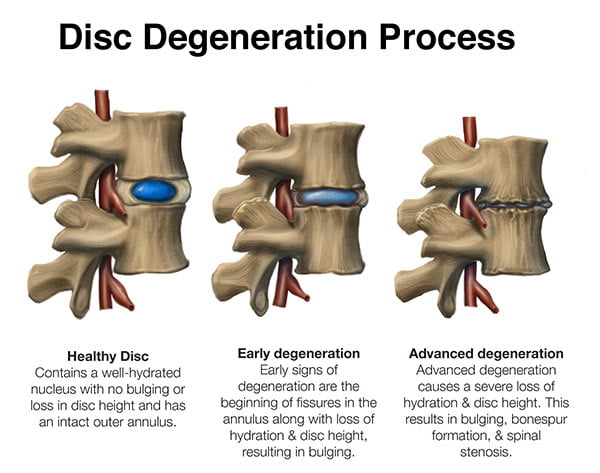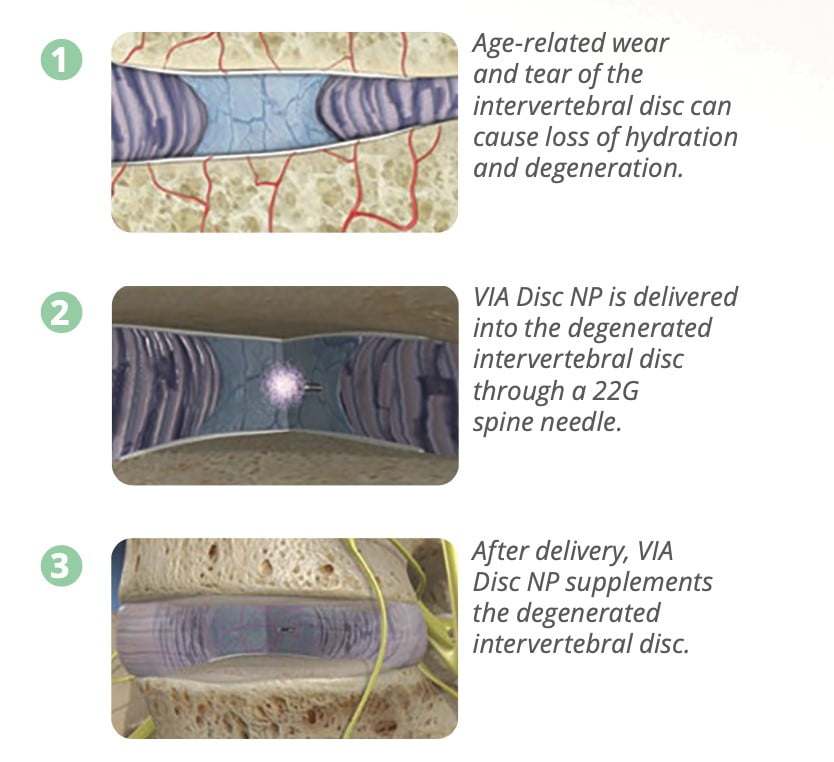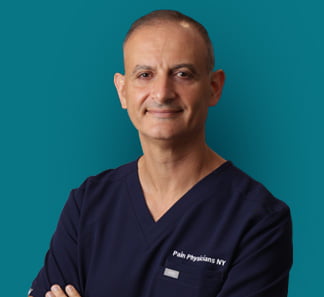If you suffer from low back pain caused by degenerative disc disease (DDD) or discogenic pain, VIA Disc could be an option – not only for relieving the pain but reversing the damage and repairing the discs from the inside. This cutting-edge therapy is a non-surgical treatment option for patients suffering from chronic lower back pain resulting from DDD.
What is VIA Disc?
VIA Disc is a non-surgical, injectable allograft that utilizes allogeneic tissue and micronzed disc material to repair degenerative discs. It is a proven therapy that has been shown in clinical trials to repair damage to degenerative discs and provide significant pain relief and improved function.
How Can Intervertebral Discs Degenerate?
 Intervertebral discs can deteriorate through normal aging and injury, causing dehydration, flattening, and loss of natural cushioning. Just like grapes lose water over time and turn into raisins, your intervertebral discs undergo a similar dehydration process. This process leaves your discs vulnerable to motion stress, strains your spinal nerves, and can result in lower back pain.
Intervertebral discs can deteriorate through normal aging and injury, causing dehydration, flattening, and loss of natural cushioning. Just like grapes lose water over time and turn into raisins, your intervertebral discs undergo a similar dehydration process. This process leaves your discs vulnerable to motion stress, strains your spinal nerves, and can result in lower back pain.Degenerative disc disease is a common cause of low back pain, with approximately 62% to 84% during people’s lifetime. The treatment of the low back degenerative disc disease always starts with physical therapy, medications followed by injections. The next treatment step for those who fail conservative therapy has been a surgical intervention- spinal fusion.
The spinal fusion reduces pain by eliminating motion at the affected segment. Understandably, the mechanics of the spine are changed, which in turn increases stress on neighboring spinal segments. Complications of fusion are severe and include failure to fuse/instability, hardware-related issues (breakage, local pain), increased adjacent segment degeneration.
As many as one-third of post-fusion patients continue to experience symptoms, often leading to repeated operations. Most of these patients are worse than they were before the surgery. In many cases, the pain is attributed to torn and leaky discs. Fluid leakage from the discs causes inflammation of nerves that in turn will result in radiculopathy, also known as sciatica.
As of January 1, 2021, VIA Disc procedure is Covered Under Medicare. It is the first “off-the-shelf” allogeneic graft that is ready to use and does not require invasive harvesting of one’s own tissue.
How Does VIA Disc NP Work?
VIA Disc is injectable therapy that delivers allogeneic disc material inside the damaged disc that tricks the disc into healing and repairing itself. Using a proprietary cell line and preparation system, the graft is injected through a 22g needle into the damaged disc. Over the course of several weeks after the injection, the graft will begin to supplement the disc, causing it to regenerate and repair.

What to Expect with VIA Disc NP?
Pre-Procedure
The nucleus pulposus particulate is mixed together with saline for delivery into your intervertebral disc.
Intravenous antibiotics may be given before the VIA Disc NP Procedure to reduce risk of infection.
Procedure
The VIA Disc NP procedure is performed under strict sterile conditions.
The VIA Disc NP procedure can be performed under local anesthesia or moderate sedation may be recommended by your physician. A procedure involving your pain-generating intervertebral disc can be painful.
During the procedure, your physician will use fluoroscopy (a computer tomography scan that continues to take images during the procedure so that the physician can see where the needle is going).
Your physician will insert a needle through the skin and muscle into the center of the intervertebral disc. VIA Disc NP will slowly be delivered into the center of the intervertebral disc.
Post-Procedure
You may experience pain and soreness after the procedure, which is normal. This pain may be due to increased pressure within your intervertebral disc.
It is important to follow your physician’s instructions after the procedure. You may be instructed to keep your activity to the normal activities of daily life and limit physical or strenuous activity for 72 hours post-procedure.
Your physician may prescribe certain pain medications (e.g. analgesics, steroid dose pack, muscle relaxants). You may experience moderate to severe pain after injection into an intervertebral disc, and oral medications may be needed promptly to treat this post-injection pain and discomfort. An ice pack may be given to place over the injection site in the event of post-injection site discomfort. Your physician may suggest a back brace or recommend physical therapy to make you feel more comfortable following your procedure.
A follow-up appointment will typically be scheduled two to four weeks after the procedure to monitor your pain and comfort. Additional follow-up appointments may be scheduled at the discretion of your physician to assess your condition.
It is important that you consult with your physician for medical advice, including any questions you may have regarding the VIA Disc NP product or the associated procedure.

Boleslav Kosharskyy, MD, is a top-rated, best-in-class interventional pain management doctor. He is board-certified in Anesthesiology, Interventional Pain Medicine, and Palliative Care.
Dr. Kosharskyy is an Associate Professor of Anesthesiology and Rehabilitation Medicine at Albert Einstein Medical College. He’s also the Associate Medical Director of Pain Medicine and Director of Anesthesia for the Joint Replacement Center at Montefiore Medical Center and Albert Einstein Medical College.
He is an active member of the American Society of Anesthesiology (ASA), the American Society of Regional Anesthesia and Pain Medicine (ASRA), and the New York State Society of Anesthesiologists (NYSSA)
